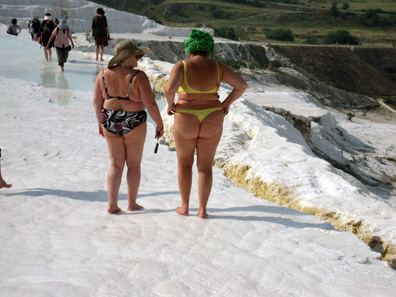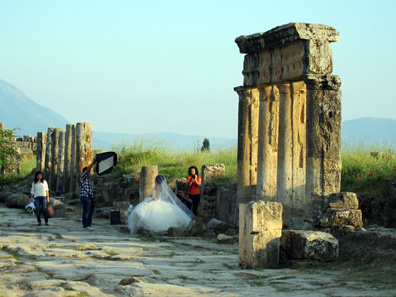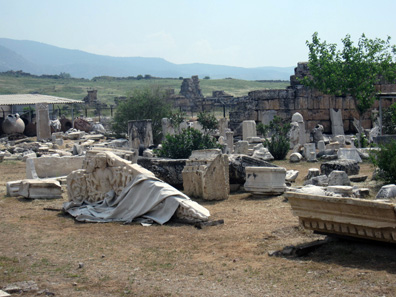by Björn Schöpe
May 30, 2013 – Generally states and institutions do not invest sufficiently into culture and education as journalists and intellectuals usually deplore – and, alas, too often they are right. So it seems a welcome news to hear from Turkey that the state and the provincial administration is increasingly investing into the important site of Hierapolis. However, what we learn has a certain negative connotation.
Italian archaeologists have conducted the Hierapolis excavation for 56 years. Photo: KW.
Since 56 years Italian archaeologists from the university of Lecce in southern Italy have excavated Hierapolis in western Turkey, a city that was famous in antiquity for its thermal baths. The excavations are considered as successful. A website of the project offers many information, there are numerous publications, thesis and sub-projects dedicated to the study of this city. Particularly in the last months the excavation made headlines in the newspapers. First, the archaeologists announced the discovery of the tomb of the apostle Philipp which had been searched for since long. And then, recently in 2013 the head of the Italian team, professor Francesco d’Andria, said that they had found as well the Plutonion, a temple known in antiquity as a gate to the underworld. (D’Andria, actually, has been part of the Italian project since its very beginning 56 years ago when he was still an undergraduate student.) So, apparently the Italians do not lack in achievements.
The typical tourist is not interested in the site of ancient Hierapolis but in taking a warm bath. Photo: KW.
However, the mayor of Denizli, the city on whose territory Hierapolis is situated today, was not satisfied with the results. Abdülkadir Demir campaigned to make a Turkish team of archaeologists excavate ‘around the clock’, twelve months per year. The Italians will assist them due to their long-lasting experience. Mr Demir admits that ‘there have been important findings and restorations for 56 years, but it is not enough for us’.
Professional photo session in the middle of the ruins. Photo: KW.
During the last two years the Italian excavations have been criticised since some people judged them as advancing too slowly. As Mr Demir stated the Turkish initiative will not incur financial problems since the ministry and the provincial administration ‘will provide the necessary budget.’
A view of the magazine of the Hierapolis museum. Photo: KW.
The details of these plans have not yet been communicated, so we must wait for valuing them. Though, a certain uneasy feeling should be permitted. As experience has shown, archaeological excavations generally do not have issues with the lack of ‘findings’ but much more with what comes after (especially since too often it does not come): documentation, conservation, academic study, publication, and, last but not least, presentation to the public. All these things cost more money than excavating and lasts often years or decades. (Very aptly a reader of the online article that published this news commented by saying that archaeology is ‘not just clearing away the dirt’ …) Let’s hope that the financial budget covers all this following work too. And we may be curious to learn when the team excavating twelve months a year will be able to do the other parts of archaeological work.
The impressive monuments of Pompeii are difficult to preserve. Photo: Morn the Gorn / http://creativecommons.org/licenses/by-sa/3.0/deed.en
However, if the focus will be on excavation and presentation of impressive monuments in order to attract even more tourists, we should keep in mind another deterrent example in Italy: Pompeii. The city buried by Mt Vesuvius has preserved for posterity ancient life in an incomparable manner. After having excavated quite fast a gigantic area, modern archaeologists are glad for everything still under the soil and protected. Because the state does not provide enough money for protecting the excavated and restored monuments and hence this unique site is becoming again a ruin – without the opportunity of being revived another time. Let’s hope that Hierapolis will be spared of this future.
The news (and the comment of a certain Scott Newman) is available on the website of Hurriyet Daily News.
You can find the informative website of the Italian archaeological mission here.
The heritage of Hierapolis is presented on the UNESCO website.
A paper of a conference held in 2003 on the conservation issue of Pompei is available on the website of the World Monuments Fund.









